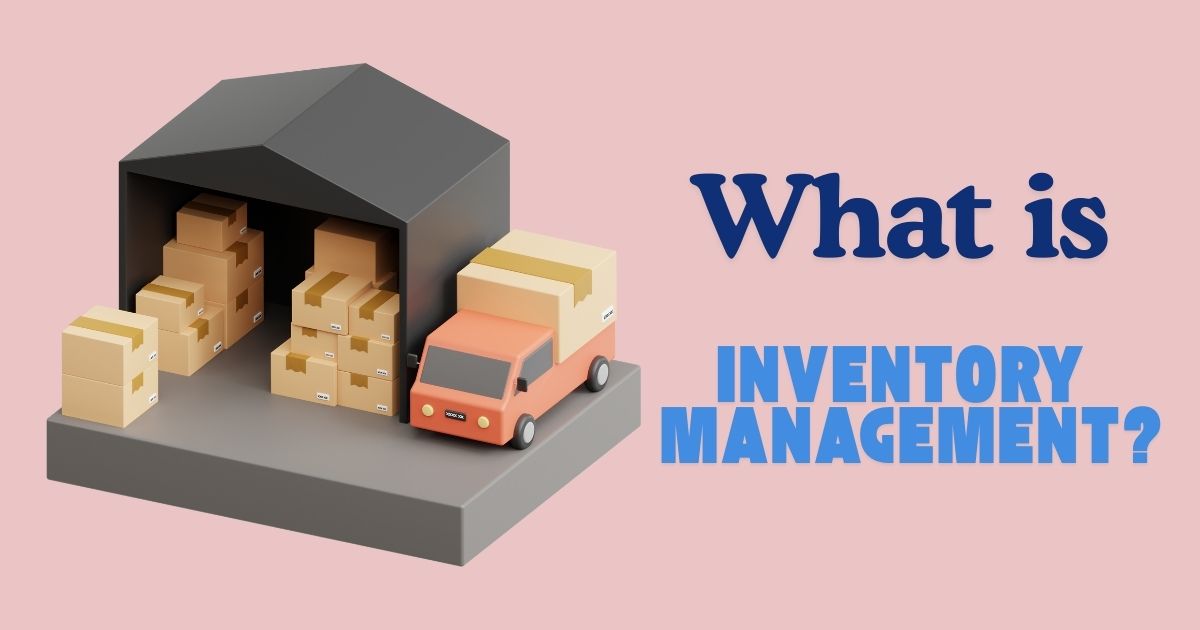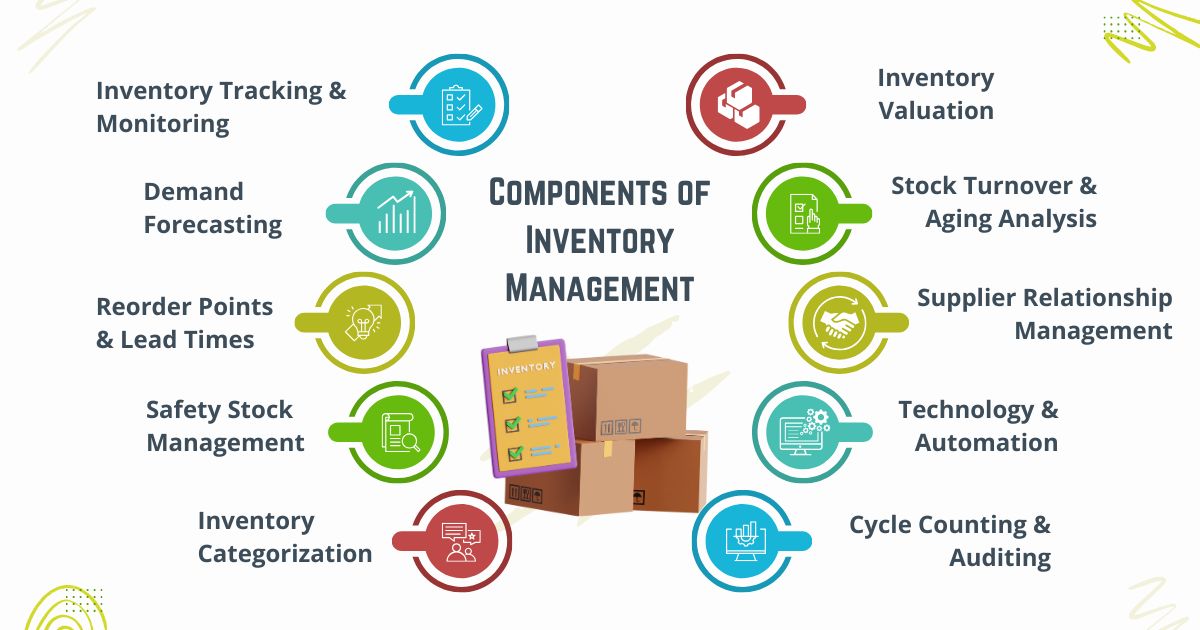What is Inventory Management? Benefits, Methods, & Examples
How can a business make products flow seamlessly, shelves are always stocked just right, and customers leave satisfied every time? That’s the power of effective inventory management — it can hold operational success, minimize costs, and prevent disruptions.
This article explores the key aspects of inventory management, including its benefits, objectives, methods, tools, and the different types of inventory.
What is Inventory Management?

Inventory management is the systematic process of sourcing, storing, and tracking a company’s goods, materials, and products. It serves the purpose of making the right items available in the right quantities at the right time to meet customer demand while minimizing costs.
With effective inventory management, businesses can reduce waste, improve cash flow, and enhance overall efficiency, whether managing raw materials, work-in-progress, or finished goods. Inventory management holds a vital role in maintaining operational balance and customer satisfaction.
The Benefits of Inventory Management

Inventory management is more than just tracking stock - it is a cornerstone of operational success that influences nearly every aspect of a business. Here’s a deeper exploration of its transformative benefits:
Optimized Stock Levels
Effective inventory management means a business maintains just the right amount of stock — not too much to inflate holding costs, nor too little to risk losing sales. Balancing inventory levels avoids wastage, creates availability, and improves overall operational agility.
Cost Efficiency
Overstocking leads to higher costs from warehousing, insurance, and potential obsolescence while understocking results in missed sales opportunities and dissatisfied customers. A well-managed inventory system helps minimize these financial risks, reducing the cost-per-unit and overall operational expenses.
Improved Supply Chain Performance
When businesses sync procurement, production, and distribution, inventory management enhances the entire supply chain. Businesses can respond to demand fluctuations, prevent bottlenecks, and establish reliable supplier relationships.
Enhanced Cash Flow
Holding excessive inventory ties up capital that could be used elsewhere in the business. Effective inventory management makes faster stock turnover, releasing trapped cash to improve liquidity and fund growth initiatives.
Better Customer Satisfaction
Inventory management is a pedestal in which businesses can consistently meet customer demand without delays or stockouts. Reliable inventory availability fosters trust and loyalty. These are critical to long-term customer relationships.
Data-Driven Decision-Making
Modern inventory systems provide real-time data on stock levels, demand trends, and inventory movement. These insights allow businesses to forecast demand more accurately, make informed purchasing decisions, and align inventory strategies with market trends.
Waste Reduction and Sustainability
Inventory management reduces overproduction and spoilage, particularly in industries dealing with perishable goods. This minimizes financial loss, supports sustainability goals by reducing waste and resource consumption.
Risk Mitigation
Having a well-structured inventory system reduces the risks of theft, damage, and loss. It also offers contingency planning, such as maintaining safety stock for unexpected disruptions or demand surges.
Improved Productivity
Organized inventory systems streamline operational workflows. Based on it, employees can locate, manage, and dispatch goods faster. This boosts productivity and reduces the time spent on manual tasks.
Key Components of Inventory Management

Effective inventory management relies on several interconnected components that work together:
Inventory Tracking and Monitoring
Inventory tracking refers to the systematic process of recording the movement of inventory items from acquisition to usage or sale. This process maintains accurate stock records, avoids overstocking or stockouts, and identifies the status with the location of inventory at any given time. Common methods for inventory tracking include barcode systems, RFID (Radio Frequency Identification) technology, and manual logging.
On the other hand, inventory monitoring is the ongoing oversight of inventory levels to detect discrepancies. The primary purpose of monitoring is to maintain sufficient stock availability, identify inefficiencies, and respond quickly to any issues in the supply chain. Modern tools, including inventory management software and IoT-enabled sensors, provide real-time updates and analytics to streamline the monitoring process.
Demand Forecasting
Demand forecasting is the prediction of future customer demand to optimize stock levels. It uses historical data, market trends, and statistical models to anticipate the quantity of products customers are likely to need within a specific timeframe.
The primary goal of demand forecasting is to strike a balance between supply and demand. There are several methods of demand forecasting, categorized into qualitative and quantitative approaches. Qualitative methods rely on expert opinions, market research, and customer surveys. They are useful when historical data is limited or when launching new products.
Quantitative methods, on the other hand, use statistical models such as time-series analysis, regression models, and machine learning algorithms to analyze historical sales data and predict future demand. Seasonal trends, economic indicators, and promotional activities are also factored into these forecasts to improve accuracy.
Reorder Points and Lead Times
Reorder points and lead times are essential for avoiding stockouts, which can lead to lost sales and operational delays, while also minimizing excess inventory that increases carrying costs.
Reorder Points (ROP) represent the stock level at which a new order must be placed to replenish inventory before it runs out. It is calculated by factoring in average daily usage, lead time, and a safety stock buffer to account for unexpected demand or supply delays. The formula for calculating the reorder point is:
ROP = (Average Daily Usage × Lead Time) + Safety Stock.
For instance, if a product’s daily usage is 20 units, the lead time is 5 days, and safety stock is 50 units, the reorder point would be:
(20 × 5) + 50 = 150 units.
Lead Time refers to the period between placing an order and receiving the inventory. It encompasses supplier processing, shipping, and receiving activities. Lead time is a critical factor in calculating reorder points, as longer lead times require higher stock levels to avoid interruptions in supply. Lead times can vary depending on supplier reliability, shipping methods, order quantities, and external disruptions such as weather or logistical issues.
The interrelation between reorder points and lead times is significant because the reorder point calculation directly incorporates lead time. If lead times increase due to supplier delays, the reorder point must be adjusted to maintain stock availability during the extended wait. Conversely, shorter lead times enable businesses to lower their reorder points, reducing inventory carrying costs without risking stockouts.
Safety Stock Management
The purpose of safety stock is to prevent stockouts, which can lead to lost sales, dissatisfied customers, and operational inefficiencies. Safety stock provides a cushion for businesses to continue fulfilling orders even when unforeseen events occur.
Businesses aiming for higher service levels often maintain larger safety stock to enhance customer satisfaction.
A common formula for calculating safety stock is:
Safety Stock = Z × σd × √L
Where:
Z represents the desired service level factor, based on the probability of avoiding a stockout.
σd is the standard deviation of demand during a given period.
L is the lead time.
For example, if a company targets a 95% service level, Z would be 1.65. Combining this with demand variability and lead time helps businesses calculate the optimal safety stock required to maintain their desired performance level.
However, safety stock management comes with challenges. Excessive inventory can lead to increased carrying costs and waste, making it essential to strike a balance.
Inventory Categorization
Inventory categorization organizes inventory items into specific groups based on predefined criteria. Businesses can prioritize inventory control, optimize stock levels, and enhance decision-making.
One widely used method of inventory categorization is ABC analysis, which divides items into three groups: A, B, and C. Businesses should manage high-impact items effectively while simplifying the handling of less critical inventory.
Another method is FSN analysis, which classifies inventory based on movement speed: fast-moving, slow-moving, and non-moving items. Similarly, VED analysis, often used in healthcare and manufacturing, categorizes items as vital, essential, or desirable. So, critical items are always available while controlling costs for less crucial ones.
HML analysis categorizes inventory based on unit cost, dividing items into high-cost, medium-cost, and low-cost groups. Meanwhile, SDE analysis groups items into scarce, difficult, and easy-to-procure categories.
Inventory Valuation
Inventory valuation is the determination of the monetary value of inventory held by a business at any given time. By accurately valuing inventory, businesses can better understand their financial health, determine the cost of goods sold (COGS), and comply with accounting standards and tax regulations.
Determines the financial value of inventory using methods like FIFO (First In, First Out), LIFO (Last In, First Out), or Weighted Average Cost.
Several factors influence inventory valuation. These include market conditions, such as inflation or deflation, and the accounting standards that businesses must follow (GAAP, IFRS). Retail companies often prefer FIFO, while manufacturers may benefit from LIFO or WAC.
Stock Turnover and Aging Analysis
Stock turnover and aging support companies to reduce costs, improve cash flow, and enhance operational efficiency by identifying inefficiencies and addressing them proactively.
Stock turnover, also known as inventory turnover, measures how frequently inventory is sold or used over a specific period. It is calculated using the formula:
Stock Turnover Ratio = Cost of Goods Sold (COGS) / Average Inventory
A high stock turnover ratio indicates efficient inventory movement and strong demand, while a low ratio signals potential overstocking or slow-moving products. High turnover contributes to better cash flow, reduced holding costs, and improved responsiveness to market trends.
To boost stock turnover, businesses can align procurement with demand forecasts, offer promotions for slow-moving stock, and optimize reorder points and quantities.
On the other hand, the aging analysis evaluates how long inventory items have been held in stock by categorizing them into age brackets (e.g., 0–30 days, 31–60 days, etc.). Aging analysis reduces the risk of obsolescence, improves financial health by avoiding write-offs, and enhances inventory accuracy.
Supplier Relationship Management
Supplier Relationship Management (SRM) has a mission of building and maintaining effective partnerships with suppliers. It makes the seamless flow of materials, minimizes risks in the supply chain, and improves overall operational efficiency.
A key goal of SRM is to create a collaborative environment - businesses and suppliers work together to meet mutual objectives. This alignment helps prevent stockouts, overstocking, or delays that could disrupt operations or customer satisfaction.
Risk mitigation is another critical aspect of SRM. A well-managed supplier relationship helps businesses anticipate and address potential disruptions, such as delays due to raw material shortages or geopolitical issues. Diversifying the supplier base and developing contingency plans further strengthens the supply chain and minimizes vulnerabilities.
Technology and Automation
Technology and automation have revolutionized inventory management. It became a more efficient, accurate, and scalable process.
One of the most significant technological advancements in inventory management is the use of inventory management software. Tools like Enterprise Resource Planning (ERP) systems integrate inventory data with other business functions such as procurement, sales, and finance.
Automation technologies, such as barcode scanning and Radio Frequency Identification (RFID), have intensified the accuracy and speed of inventory tracking. Barcode scanning simplifies the recording of stock movements, reducing manual errors. Similarly, RFID technology tracks inventory in real-time without line-of-sight scanning, making it ideal for large warehouses or high-value items.
The rise of Artificial Intelligence (AI) and Machine Learning (ML) has further advanced inventory management by enabling predictive analytics. AI-powered systems can analyze historical data, market trends, and consumer behavior to forecast demand accurately. Businesses optimize reorder points, prevent stockouts, and minimize overstocking.
Warehouse automation is another transformative aspect of inventory management. Automated storage and retrieval systems (AS/RS) and autonomous mobile robots (AMRs) reduce the time for picking, packing, replenishing inventory. These systems not only increase operational efficiency but also improve worker safety by handling repetitive or hazardous tasks.
Cycle Counting and Auditing
Cycle counting and auditing maintain accurate inventory records and create operational efficiency. These processes help businesses identify discrepancies, minimize losses, and improve decision-making.
Cycle counting is a periodic inventory auditing technique where a subset of inventory is counted regularly instead of conducting a full physical inventory count. Businesses often use this method to verify the accuracy of inventory records without disrupting daily operations. Cycle counts are typically conducted on high-value or high-turnover items more frequently than less critical items, following methodologies like ABC analysis.
On the other hand, auditing in inventory management evaluates inventory practices, processes, and records. Audits can be internal, conducted by in-house teams, or external, performed by independent auditors. The goal of auditing is to assess the overall integrity of inventory data, compliance with policies, and effectiveness of inventory controls.
While cycle counting identifies and rectifies specific discrepancies, auditing takes a broader approach by examining the root causes of inventory issues. For instance, an audit might uncover systemic problems in procurement, storage, or tracking processes that contribute to recurring inaccuracies.
Inventory Management Methods

There are various methods of inventory management, each tailored to address specific operational needs and business objectives. Here’s an overview of the most common inventory management methods:
Just-In-Time (JIT) Inventory
Just-In-Time (JIT) reduce waste and improve efficiency by maintaining minimal inventory levels. It aligns inventory supply with production schedules and actual customer demand. In a JIT system, materials and goods are ordered or produced only when needed. JIT is particularly effective in industries with stable, predictable demand and reliable supply chains, such as automotive manufacturing, consumer electronics.
A key principle of JIT is demand-driven supply, meaning inventory replenishment is based on real-time demand rather than forecasts. It needs close collaboration with suppliers to make timely delivery of raw materials and components.
JIT improves cash flow, as businesses do not tie up capital in surplus stock. Additionally, JIT boosts productivity by streamlining processes and pushing resources only where they are needed.
Economic Order Quantity (EOQ)
Economic Order Quantity (EOQ) searches for the optimal order quantity that minimizes the total cost of inventory. It balances two primary costs: ordering costs (incurred when placing orders) and holding costs (associated with storing inventory).
The EOQ model operates on the principle that ordering larger quantities reduces the frequency of orders and, therefore, lowers ordering costs. However, larger order sizes increase holding costs due to higher storage requirements and potential risks of obsolescence. The EOQ formula identifies the point where these costs are minimized.
ABC Analysis
ABC Analysis categorizes inventory items based on their value and significance to the business. The goal is to prioritize resources and focus on the most critical items.
In ABC Analysis, inventory is divided into three categories. A items are high-value products that have a significant impact on the company’s profitability but typically make up a small portion of the total inventory (around 10-20% of items, accounting for 70-80% of the total value). B items represent moderate-value products that fall between A and C categories, constituting about 20-30% of items and 15-25% of value. C items are low-value products with minimal impact on revenue, often comprising 50-70% of inventory but only 5-10% of the total value.
The key principle of ABC Analysis is to make efforts on A items, as they drive the majority of the business’s profitability. B items require moderate attention, while C items can be managed with minimal effort and resources.
ABC Analysis can be subjective and may vary depending on the organization’s goals and market conditions. Categories are not static and may change over time due to shifts in demand. Furthermore, this method potentially overlooks other critical factors like lead time or product importance.
First-In, First-Out (FIFO)
First-In, First-Out (FIFO) assumes the oldest inventory (first-in) is sold or used first (first-out). This method is particularly effective in industries where inventory items are perishable, have expiration dates, or are prone to obsolescence, such as food, pharmaceuticals, and fashion.
FIFO is also widely used in accounting to value inventory and calculate the cost of goods sold (COGS). One of the main advantages of FIFO is that it provides a more accurate reflection of inventory costs, especially during times of inflation. Since older inventory is typically cheaper, using FIFO results in lower COGS and higher reported profits.
However, FIFO has limitations. During periods of rising prices, FIFO may inflate profit margins, which can lead to higher tax liabilities. It may also not align with physical inventory flows in industries where newer products are consumed first due to customer preferences or operational requirements.
Last-In, First-Out (LIFO)
The principle of Last-In, First-Out (LIFO) is that newer inventory is consumed or sold before older stock. This method is beneficial during periods of rising prices because it assumes the most recent (and typically higher-cost) inventory is used first. As a result, LIFO reports higher COGS, reducing taxable income and providing tax advantages. For businesses aiming to minimize tax liabilities, this can be a strategic financial tool.
However, LIFO has notable drawbacks. It can result in outdated or unsold older inventory accumulating over time, known as "LIFO layers," which may become obsolete. Additionally, LIFO is not accepted under International Financial Reporting Standards (IFRS), limiting its use to companies following Generally Accepted Accounting Principles (GAAP), primarily in the United States.
Perpetual Inventory Management
Perpetual inventory management continuously tracks inventory levels in real time through the use of automated systems, such as barcode scanners, RFID technology, or inventory management software. Unlike periodic inventory systems, the perpetual system provides a dynamic and accurate record of stock movements, including purchases, sales, returns, and adjustments.
Perpetual inventory systems upgrade inventory accuracy by reducing human error and maintaining up-to-date records. This real-time tracking prevents stockouts or overstocking.
However, perpetual inventory management also has challenges. Implementing and maintaining the required technology can be expensive, especially for small businesses. The system's accuracy depends on proper integration and disciplined operational practices. Errors in data entry or system malfunctions can lead to discrepancies, resulting in regular audits to verify physical inventory.
Safety Stock Inventory
Safety stock inventory refers to the extra stock that businesses maintain to protect against uncertainties in demand, supply, or lead times. It acts as a buffer to prevent stockouts. Based on stock inventory, operations run smoothly even when unexpected events occur, such as sudden spikes in demand, supplier delays, or errors in inventory forecasting.
Dropshipping
Dropshipping is an inventory management method where a retailer does not keep products in stock but instead transfers customer orders and shipment details directly to a supplier or manufacturer. The supplier then ships the goods directly to the customer.
Dropshipping offers several advantages. It requires minimal capital to start, as there is no need to purchase or store inventory. Businesses can offer a wide range of products without worrying about storage space or logistics. Additionally, it eliminates the risk of unsold inventory, making it a low-risk model for testing new products or markets.
However, dropshipping has challenges. Profit margins are often lower compared to traditional retail models due to supplier fees and shipping costs. Retailers have limited control over the supply chain. Many issues are difficult to solve with product quality, shipping delays, or inventory shortages. Maintaining customer satisfaction can be difficult if problems arise that are beyond the retailer’s control.
Vendor-Managed Inventory (VMI)
Vendor-Managed Inventory (VMI) is a method by which the supplier or vendor is responsible for monitoring, managing, and replenishing the inventory of their products at the customer's location. Under this approach, the vendor has access to the customer’s inventory levels and usage data, often through shared systems or electronic data interchange (EDI).
Tools of Inventory Management
The key tools of inventory management include:
Inventory Management Software
Tools like Zoho Inventory, NetSuite, or QuickBooks help track inventory levels, sales, orders, and deliveries in real time.
Barcode Scanning Systems
Barcode scanners streamline inventory tracking by automating the data entry process, reducing errors, and providing faster updates on stock levels.
Enterprise Resource Planning (ERP) Systems
ERP systems like SAP, Oracle, or Microsoft Dynamics integrate inventory management with other business functions.
Radio Frequency Identification (RFID)
RFID tags enable real-time tracking of inventory using radio waves, offering greater visibility and accuracy compared to traditional barcode systems.
Just-In-Time (JIT) Systems
JIT tools make inventory is received only when needed, minimizing storage costs and reducing waste.
Economic Order Quantity (EOQ) Calculators
EOQ calculators support businesses determine the optimal order quantity to minimize total inventory costs.
Inventory Forecasting Tools
Forecasting tools use historical data and analytics to predict demand, enabling businesses to maintain optimal inventory levels and avoid stockouts.
ABC Analysis Tools
These tools classify inventory into categories (A, B, C) based on value and importance, prioritizing management efforts for critical items.
Spreadsheets and Templates
Tools like Microsoft Excel or Google Sheets allow small businesses to manage inventory manually using customizable templates.
Automated Reorder Systems
These tools set thresholds for stock levels and trigger automatic reorders when inventory drops below a predefined point.
Example of Inventory Management
An example of Inventory Management is a retail store managing its stock using the Just-In-Time (JIT) method.
Suppose a clothing store sells seasonal apparel, such as summer dresses. To avoid overstocking and reduce holding costs, the store uses JIT inventory management. They work closely with their supplier to receive shipments of summer dresses only when inventory levels drop to a predefined threshold, based on current demand and sales trends.
For example:
At the start of summer, the store forecasts demand for 1,000 dresses over the season.
The supplier delivers an initial stock of 300 dresses.
As sales occur and inventory drops to 50 dresses, an automated reorder system notifies the supplier to replenish stock with another batch of 300 dresses.
This cycle continues throughout the season. The store has just enough inventory to meet customer demand without overstocking unsold dresses.
Some courses may be useful to you. Please click on the course name below to learn more:
Business Branding With Personality: Build An Authentic Brand
In this course you’ll learn the science behind why personality is the key for business brands to human engagement and the framework that the biggest brands in the world use in order to develop their personalities that connect with their audience.
Price to Profit: Psychology & Science of Pricing
Price is what makes you money so deep understanding of how customers think about price can help you win customers and make more money. Pricing Strategies are powerful weapons in your hands to increase sales and more importantly profit. This course is pragmatic and applicable. It digs deep into scientific research of psychology and pricing in addition to the wisdom of pricing scholars and gurus. I have collected for you not only the tips and tricks to hack into customers' perception of price but also the overall strategies and consideration to coordinate your pricing strategies in any given situation or context.
Master the Shopper Experience to build your retail business.
If you want to understand your shoppers in more depth, build a store format and system that encourages them to linger longer, spend more and tell their friends about your business or product, then this is the course for you.
Conclusion
Effective inventory management is essential for businesses to maintain optimal stock levels, reduce costs, and meet customer demands. With the right strategies in place, inventory management becomes a cornerstone for sustainable growth and long-term success.
Do you want to learn more about this interesting business knowledge? You can refer to Skilltrans courses. We are always ready to lead you to the door of knowledge.

Meet Hoang Duyen, an experienced SEO Specialist with a proven track record in driving organic growth and boosting online visibility. She has honed her skills in keyword research, on-page optimization, and technical SEO. Her expertise lies in crafting data-driven strategies that not only improve search engine rankings but also deliver tangible results for businesses.



